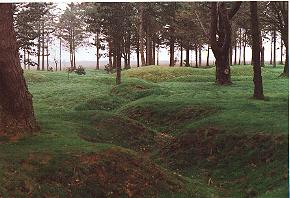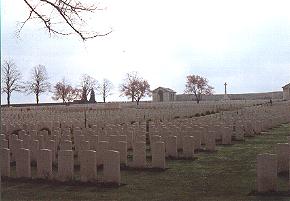The Welsh Regiment

1/6th (Glamorgan) Battalion
August 1914 : in Swansea. Part of South Wales Brigade, which was Army Troops, unallocated to a Division. 29 October 1914 : landed at (Le) Havre and moved to Lines of Communication. 5 July 1915 : attached to 84th Brigade, 28th Division. 23 October 1915 : transferred to 3rd Brigade, 1st Division. 15 May 1916 : became Pioneer Bn. to 1st Division.
84th Brigade
1st Bn, the Welsh (joined December 1914)
1/6th (Glamorgan) Bn, the Welsh (joined July1915, left October 1915)
1st Division
Divisional Troops
1/6th (Glamorgan) Bn, the Welsh (joined as Pioneers May 1916)
took part in
The Battle of Albert (first phase of the Battle of the Somme 1916)
The Battle of Bazentin (second phase of the Battle of the Somme 1916)
The Battle of Pozieres (third phase of the Battle of the Somme 1916)
The Battle of Flers-Courcelette (sixth phase of the Battle of the Somme 1916)
The Battle of Morval (seventh phase of the Battle of the Somme 1916)
The German Retreat to the Hindenburg Line
The Division was warned to prepare for an operation along the Belgian coast in Summer 1917 and several mobile units were attached in readiness. The operation was cancelled when the initial assaults in the Third Battle of Ypres failed to progress as expected.
The Second Battle of Passchendaele (eighth phase of the Third Battle of Ypres)
The Battle of Estaires (first phase of the Battles of the Lys) (2nd Brigade)
The Battle of Hazebrouck (third phase of the Battles of the Lys) (3rd Brigade)
The Battle of Bethune (sixth phase of the Battles of the Lys)
The Battle of Drocourt-Queant (second phase of the Second Battles of Arras 1918)
The Battle of Epehy (second phase of the Battles of the Hindenburg Line)
The Battle of the St Quentin Canal (fourth phase of the Battles of the Hindenburg Line)
The Battle of Beaurevoir (fifth phase of the Battles of the Hindenburg Line) (3rd Brigade)
The Battle of the Selle
The Battle of the Sambre
In the above action, the Division fought the Passage of the Sambre-Oise Canal.

The Battle of the Somme
1st July - 18th November 1916
One of the most important campaigns in which the British Army has ever been engaged, the dogged fighting on the Somme has shaped modern memory of the First World War.
Why did the British Army attack on the Somme in 1916? >> See why, in detail
The offensive campaign of 1916 - initially conceived to be a war-winning simultaneous strike on three fronts by all Allies with maximum force - came down to a few Divisions of the British Army attacking on ground not of their choosing and where there was no possibility of strategic gain.
How was the initial plan of attack developed? >> See the plan, in detail
There was disagreement between Commander-in-Chief and the Army commander who had to carry out the attack, about how it should be done. Haig's plan was to capture ground, breaking past the first enemy line and into the second enemy line on the first day. All possibilities to exploit enemy disorganisation should be grasped from then on. Yet at the same time, the army applied rigid, inflexible, tactics as regards the way their infantry should conduct the attack.
The immense preparation for battle >> See the preparations, in detail
The area chosen for battle was a quiet agricultural area, not well furnished with railways and roads capable of supporting supply to 400,000 men.
Which British units took part?
It is perhaps easier to say which ones did not. For of the 56 British Divisions at the time, no fewer than 53 went through the Somme in 1916; of the remainder another one fought at Fromelles in a Somme-related diversion.
What happened? >> See what happened, day by day
After a disastrous opening for the British attack, the Allied offensive pushed on yard by yard through a hot summer and came eventually halted as the mud of winter closed in. Little ground had been taken, but the German army had been mortally wounded.
Casualties
According to the British official history of the battle, total Allied casualties amounted to almost 630,000 and German around 660,000. British casualties reported by the Adjutant General were 419,654, of whom some 5% were missing at roll call but may have subsequently reported. Staggering figures, especially when taken alongside those at Verdun where fighting between French and German continued throughout 1916.
Ordinary Heroes
This site features the stories of ordinary soldiers who fought in the Battle of the Somme 1916:
More
KEEN
UTTING
ROBSON
FUREY
WYLES
CLAYTON
War Diaries
This site also features the daily war diaries of units that took part in the Battle of the Somme 1916:
168th Brigade RFA 8th Northumberland Fusiliers 18th West Yorkshire 2nd Royal Irish Regiment More
Who won?
It has been asserted by those of the "dunderhead generals / futile" school of thought that the Somme was conducted with little skill or imagination; that it went on too long; that it was a mere battle of attrition; that the Germans won by simply inflicting more casualties on the Allies than they suffered themselves; that it should not have taken place. Is this right?
The battlefields today >> Take a virtual tour of the 1916 Somme battlefields
Before and after the Somme
Actions in Spring 1916
Operations on the Ancre, 1917
All I can find out so far. Watch this space.

0 Comments:
Post a Comment
<< Home